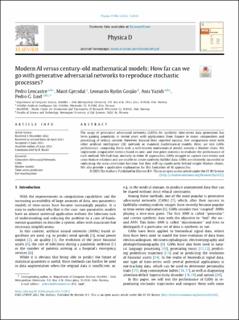Modern AI versus century-old mathematical models: How far can we go with generative adversarial networks to reproduce stochastic processes?
Peer reviewed, Journal article
Published version
Permanent lenke
https://hdl.handle.net/11250/3087278Utgivelsesdato
2023Metadata
Vis full innførselSamlinger
Originalversjon
10.1016/j.physd.2023.133831Sammendrag
The usage of generative adversarial networks (GAN)s for synthetic time-series data generation has
been gaining popularity in recent years with applications from finance to music composition and
processing of textual content. However, beyond their reported success, few comparisons exist with
other artificial intelligence (AI) methods or standard mathematical models. Here, we test GANs
performance, comparing them with a well-known mathematical model, namely a Markov chain. We
implement comparative metrics based on one- and two-point statistics to evaluate the performance of
each method. We find that, similarly to other AI approaches, GANs struggle to capture rare events and
cross-feature relations and are unable to create synthetic faithful data. GANs are relatively successful in
replicating the auto-correlation function, but they still lag significantly behind simple Markov chains.
We also provide a qualitative explanation for this limitation of AI approaches.

